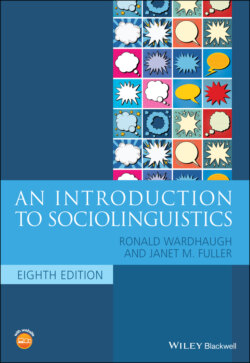Читать книгу An Introduction to Sociolinguistics - Ronald Wardhaugh, Janet M. Fuller - Страница 54
Kiezdeutsch ‘neighborhood German’
ОглавлениеThe term Dialekt, ‘dialect’ in German, as mentioned above, has historically been used solely to refer to regional varieties. While sometimes stigmatized, these dialects are at the same time integral to regional identities and seen as deeply, essentially German. While a body of literature on Gastarbeiterdeutsch (‘guest worker German’) emerged beginning in the 1970s, this variety was identified as a second language or a ‘pidginized’ variety of German, and very clearly spoken only by immigrants (e.g., Keim 1978; Pfaff 1980), and thus, not a German Dialekt. Subsequently, a body of research about multilingual language practices of multiethnic groups of urban youths in Germany showed that multilingual practices were common among urban youths of many backgrounds, including those whose families had long been in Germany (e.g., Auer and Dirim 2003; Kallmeyer and Keim 2003). While this research did show that such practices were not unique to children of immigrant background, it also did not suggest that multilingual discourse was something quintessentially German. However, when Kiezdeutsch, a way of speaking associated with multiethnic neighborhoods, was described as a German dialect (Wiese 2010, 2012), resistance to the idea of recognizing this way of speaking as a variety of the German language became apparent. The controversies surrounding this work, both in academic circles and in public discourses, exemplify the issues in social dialects in general. These issues include the label applied to the variety, identifying the features of the variety, correlations with demographic factors, and the process of the development.
In the case of Kiezdeutsch, this term was chosen by researchers because other terms used to refer to the variety in everyday speech were inaccurate (e.g., Türken‐deutsch, ‘Turks’ German’) and potentially offensive (e.g., Kanak Sprak, derived from a derogatory term for foreigners [Kanak or Kanaker] and nonstandard spelling/pronunciation of German Sprache ‘language’). However, as this case illustrates, no term is perfect. The term Kiez varies regionally in how it is used; in Berlin it is commonly used in a positive manner to refer to one’s neighborhood, indicating it is where one feels at home, but in Hamburg the term is used to refer to one particular neighborhood, the so‐called red light district. (As we will see in our discussion of African American Vernacular English and Latino Englishes below, labels for varieties are often problematic and sites of controversy; this issue will also be discussed further in the next chapter as we attempt to define social groups.)
While certain features of Kiezdeutsch do not seem to be disputed, the development and status of these features are. Wiese (2010, 2012) argues that although Kiezdeutsch does include some lexical items from languages other than German (often, Turkish), it is not a mixed language (see chapter 9 for a definition of this term); instead, the grammatical features have their roots in the German language. She refers to Kiezdeutsch as a German dialect. Auer (2013, 36) disputes this, saying it is simply a youth style of speaking which is not used consistently enough to be considered a dialect, and suggests that there are features indicating ‘unsichere Beherrschung der deutschen Morphologie’ (‘uncertain mastery of German morphology’); Glück (2017) also dismisses Wiese’s findings as the transitional speech of children and not a dialect, social or regional. Similarly, Jannedy (2010) calls Kiezdeutsch a ‘multi‐ethnolectal youth language,’ and not a social dialect.
Popular opinion about nonstandard social dialects is often that these ways of speaking are lazy, sloppy, and degenerate. Wiese (2012) aims at convincing a general audience that the features of Kiezdeutsch are part of normal language development and variation, not a bastardization through foreign influence, but this position has caused great consternation for many readers, who do not want to accept that a new dialect is possible (see Wiese 2014 for an analysis of this discourse).
Who speaks Kiezdeutsch is also represented in the literature in different ways. There is agreement that its speakers generally live in multiethnic neighborhoods, and it is referred to as a youth language, but whether it is indeed limited to young speakers has not been conclusively demonstrated. Auer (2013) discusses the speakers of Kiezdeutsch as socially marginalized youths of immigrant background, while among Wiese’s research participants are speakers with German backgrounds who are monolingual German speakers (as well as speakers of other ethnic or national backgrounds who are monolingual German speakers). More recent attitudinal research (Bunk and Pohle 2019) shows that while non‐Kiezdeutsch speakers may associate the variety with ethnicity, the speakers themselves recognize their way of speaking as indexing educational failure, economic disadvantage, and a ‘gangster image’ (2019, 98). Significantly, these speakers also identify this way of speaking as just one code in their repertoires, reporting that while they use Kiezdeutsch among friends, they speak Standard German in more formal contexts.
Finally, the process of the development of this variety is controversial. It is often assumed to be the result of language contact, meaning that the features are borrowed from other languages, especially Turkish (e.g., Auer 2013). Wiese (2010, 2012) argues for a somewhat different scenario: that this situation of language contact has created a fertile environment for internally motivated language change (see chapters 5 and 9 for discussions of contact variety development and language change more broadly).
What is clear is that Kiezdeutsch is a variety which has developed as an ingroup language; the development and use of Kiezdeutsch is intertwined with the identities of the speakers. As will be discussed for ethnic dialects, the identification with a group is a key element in the development of a social dialect.
